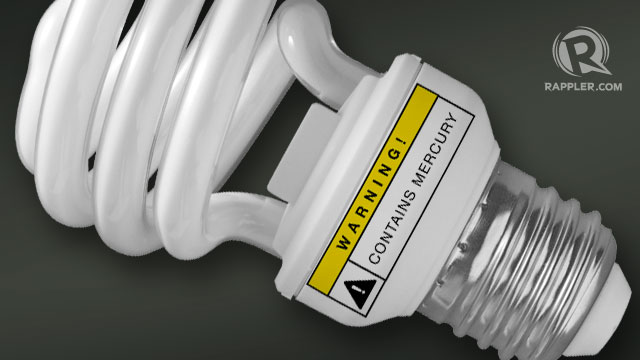SUMMARY
This is AI generated summarization, which may have errors. For context, always refer to the full article.

MANILA, Philippines – Compact fluorescent lamps (CFLs) and other mercury-containing lamps sold in the market should bear mercury warning labels, environmental and health advocates said on Tuesday, July 16.
In a common letter sent to the Departments of Trade and Industry, Energy, and Environment and Natural Resources, the EcoWaste Coalition and 17 other groups wrote that on their product labels, CFLs should disclose the presence of mercury.
“Consumers have the right to know that fluorescent lamps and other kinds of lamps contain mercury and should be handled with extreme caution, from the point of purchase to disposal, to avoid breakage and release of mercury vapor,” said Thony Dizon, Coordinator of the EcoWaste Coalition’s Project Protect.
In a press statement, Dizon also said that mercury is a potent neurotoxin of special concern for the brain development in unborn and growing children, and also for consumers or workers, particularly waste handlers and informal recyclers, who may be exposed to mercury vapor from broken or crushed lamps.
According to EcoWaste Coalition, they monitored 12 brands of CFLs that had no mercury warning labels. These included Akari, Amarflex, Delta, Firefly, GE, Luxen, Omni, Osram, Panasonic, Philips, Sylvania and Toshiba. None of them provided information either about the amount of mercury they each contain.
Hazards
Busted or spent mercury-added lamps are considered hazardous waste under RA 6969, the Toxic Substances and Hazardous and Nuclear Wastes Control Act.
RA 9003 or the Ecological Solid Waste Management Act classifies them as “special waste,” thus requiring special management and disposal separate from ordinary trash.
Although they provide energy efficiency information and other labeling requirements, CFLs may still be considered mislabeled under Article 91 of RA 7394 because of the absence of mercury warning information and other pertinent facts, environmental groups said.
Besides health and safety considerations, specifying the mercury content on the packaging and the lamp itself will facilitate proper identification and inventory of certain CFLs to be phased out by 2020 under the Minamata Convention on Mercury to be signed in October 2013, the groups said in their statement.
Mercury treaty
Under the Mercury Treaty, the manufacture, import or export of CFLs equal to or less than 30 watts with more than 5 mg of mercury per bulb will no longer be allowed by 2020.
Also to be phased out by 2020 are triband phosphor linear fluorescent lamps (LFLs) less than 60 watts with mercury content exceeding 5 mg per lamp, and halophosphate LFLs less than or equal to 40 watts with mercury content exceeding 10 mg per lamp.
In a case study on CFLs prepared by the EcoWaste Coalition and included in the United Nations Environment Programme (UNEP) 2011 “Study on the Possible Effects on Human Health and the Environment in Asia and the Pacific of the Trade of Products Containing Lead, Cadmium and Mercury,” environmental groups recommended different means to safeguard public health and the environment from mismanaged CFLs that often end up in waste heaps, bins and dumps.
Recommendations
Among their recommendations to the government were the following:
1. Adopt and enforce a deliberate policy to allow only the importation, distribution, sale and use of low-mercury CFLs and with proper labeling.
2. Reiterate the legal classification of spent CFLs as “special waste” that should be appropriately treated as hazardous waste in an environmentally-sound manner, and not simply disposed of in dumps or landfills along with residual trash.
3. Introduce Extended Producer Responsibility policy or a mandatory take-back scheme that will make manufacturers, importers, retailers or distributors responsible for the management of CFLs after their useful lives. – Rappler.com
Add a comment
How does this make you feel?
There are no comments yet. Add your comment to start the conversation.